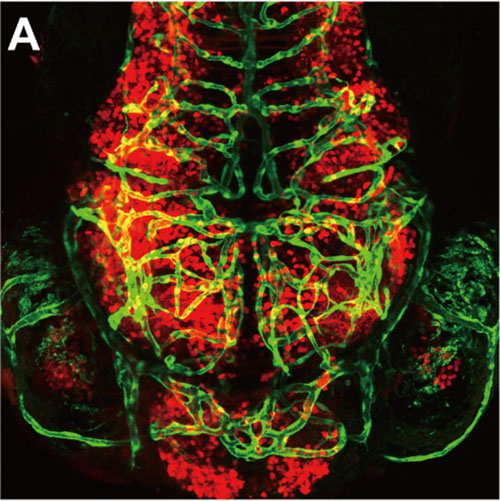Time:2017-04-24
A recent study published online in Cell Research reported that neurons transfer miR-132 into brain vascular endothelial cells (ECs) via exosomes to promote brain vascular integrity. This study was performed by Dr. DU Jiulin’s research group in the Institute of Neuroscience and the Center for Excellence in Brain Science and Intelligence Technology, Chinese Academy of Sciences.
Brain vascular integrity helps to maintain brain microenvironment homeostasis, which is critical for the normal development and function of the central nervous system. Impairment of the brain vascular integrity will exacerbate neurological diseases. It has been often proposed but rarely demonstrated that brain vascular integrity is in turn regulated by the nervous system.
To explore the role of the nervous system in regulating brain vascular integrity, Dr. DU’s group first examined the function of miR-132, a highly conserved and neuron-enriched miRNA, in brain vascular development. The researchers found that knockdown or mutation of miR-132 caused severe intracranial hemorrhage and disruption of brain vascular integrity in zebrafish larvae. To elucidate the underlying mechanism, the researchers examined the expression of junction proteins, transcytosis and other related cell types which are important for brain vascular integrity. They found that the adherens junction protein vascular endothelial cadherin (VE-cadherin, also known as Cdh5) and its intracellular partner β-catenin, but not other junctions proteins and cells, were involved in the regulation of brain vascular integrity by miR-132. By using miRNA sponge-mediated neuron-specific reduction of miR-132, researchers showed that neuronal miR-132 also can regulate the brain vascular integrity. Interestingly, up- and down-regulation of miR-132 level in neurons resulted in coordinated changes of miR-132 level in ECs, and EC-specific reduction of miR-132 also impaired VE-cadherin expression, as well as brain vascular integrity. Furthermore, combining experiments in cultured rodent cortical cells, the researchers found that neurons secreted miR-132-containing exosomes, which were then internalized by ECs in the brain, leading to an increased level of miR-132 in ECs. Consistently, impairment of exosome secretion in zebrafish larvae caused intracranial hemorrhage. Finally, through microarray and prediction algorithm, eukaryotic elongation factor 2 kinase (eef2k) was identified as a direct target of miR-132. Gain- and loss-of-function experiments showed that eef2k in ECs mediated the action of miR-132 on VE-cadherin expression and brain vascular integrity.
This study discovers a previously unidentified function of miR-132 and reveals that neuronal exosomes serve as a novel carrier in mediating neural regulation of brain vascular integrity. This finding opens an exciting avenue for the study of neuronal exosome-mediated neurovascular interactions.
This work was carried out mainly by XU Bing and ZHANG Yu, with help from DU Xufei, LI Jia, ZI Huaxing, BU Jiwen, YAN Yong, and HAN Hua, and under the supervision of Dr. DU Jiulin. It was supported by grants of the Key State Research Program of China (2012CB945101), National Natural Science Foundation of China (31325011, 31500849), China Wan-Ren Program, Shanghai Leading Talent Program, Shanghai Subject Chief Scientist Program (14XD1404100) and Yang-Fan Program (14YF1406600) from the Science and Technology Commission of Shanghai Municipality, and the Postdoctoral Research Foundation of China (2015T80458).

A) A projected confocal image of the brain vasculature of 3-dpf transgenic zebrafish larva, in which eGFP (in green) and tdTomato (in red) are respectively expressed in vascular ECs and neurons.

B) Working model. Neurons secrete miR-132-containing exosomes, which are internalized into brain ECs. In ECs, miR-132 upregulates Cdh5 expression by directly repressing eEF2K expression, promoting brain vascular integrity.
 附件下载:
附件下载: